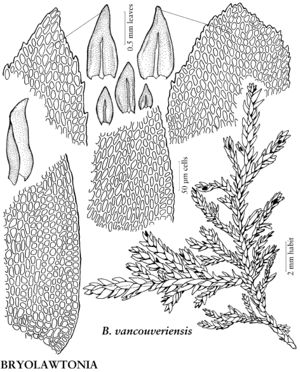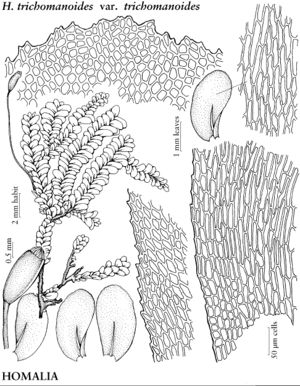Plants small to large, shelf-forming or dendroid, green, yellowish, or brownish, glossy to dull. Stems creeping, or forming stipe perpendicular to substrate; secondary branches produced regularly along stem or only distally; paraphyllia absent or present, few to many, simple or branched; pseudoparaphyllia filamentous to foliose; rhizoids present only on primary stem or branch apices that touch substrate. Primary stem leaves appressed, erect-appressed, or erect-spreading, ovate, lanceolate, or deltoid; margins entire to serrulate; apex obtuse, broadly acute, or acute; ecostate, costa double and short, or single; distal medial laminal cells rhomboidal to fusiform, smooth to papillose. Stipe leaves of dendroid plants appressed, erect-spreading, or erect, obovate, deltoid, or lanceolate; margins plane to recurved, usually entire; apex acute; costa single; distal medial laminal cells fusiform, linear to rectangular. Secondary stem and branch leaves widely erect, erect-spreading, or spreading, ovate, ovate-ligulate, oblong-ligulate, oblong-ovate, or ovate-lanceolate, symmetric or asymmetric, flat or undulate, crisped or slightly plicate; base occasionally auriculate, basal lobes absent (small lobe present at adaxial base of lateral leaves in Homaliadelphus); margins usually entire basally, slightly serrulate, serrate, or entire at apex; apex truncate, obtuse, obtuse-apiculate, or broadly to narrowly acute; costa double, single, or ecostate; basal laminal cells linear to rectangular, smooth or prorulose, walls pitted or not; distal medial cells rhomboidal, fusiform to linear, or linear-flexuose; apical cells round, oval, rhombic, rhomboidal, or fusiform. Sexual condition synoicous, autoicous, or dioicous. Seta short to long, smooth. Capsule erect, suberect, or horizontal, immersed to exserted; peristome double (single in Neomacounia); exostome with external surface smooth or cross striolate, papillose distally; endostome basal membrane low or high, segments linear to lanceolate, smooth to papillose, perforated along keel by narrow slits, cilia absent or 1–3, often connate. Calyptra cucullate, naked or hairy. Spores papillose to finely papillose.
Distribution
Nearly worldwide, temperate and tropical regions.
Discussion
Genera 29, species ca. 140 (8 genera, 14 species in the flora).
Neckeraceae traditionally has included shelf-forming (Homalia, Neckera, and Neckeropsis) and dendroid (Porotrichum and Thamnobryum) pleurocarpous mosses. As characterized by M. Fleischer (1906) and V. F. Brotherus (1924–1925), the family was divided into Neckeroideae Brotherus and Thamnioideae M. Fleischer, reflecting the two growth forms. The relationship between these two groups has been demonstrated in phylogenetic analyses (E. De Luna et al. 2000; H. Tsubota et al. 2004; A. V. Troitsky et al. 2007), where both groups are nested in a larger clade.
Selected References
None.
Lower Taxa
Illustrations
Key
| 1 | Plants dendroid; stems forming stipe, pinnate to sparsely branched distally; stem and branch leaf marginal teeth straight when present | > 2 |
| 1 | Plants shelf-forming, occasionally frondose; stems creeping, irregularly branched along stem; stem and branch leaf margins entire, slightly serrate, or serrate and teeth recurved | > 3 |
| 2 | Plants shiny; secondary stem and branch leaves flat, erect; costae slender. | Porotrichum |
| 2 | Plants slightly shiny to dull; secondary stem and branch leaves concave, erect to erect- spreading; costae stout. | Thamnobryum |
| 3 | Small lobe present at adaxial base of lateral leaves. | Homaliadelphus |
| 3 | Leaf basal lobes absent | > 4 |
| 4 | Stem and branch leaves usually imbricate | > 5 |
| 4 | Stem and branch leaves usually erect to erect-spreading | > 6 |
| 5 | Some stem and branch leaves finely plicate, ovate to ovate-oblong; apices abruptly acute to acuminate; ecostate or costae double, rarely single. | Neomacounia |
| 5 | Stem and branch leaves not plicate, ovate to elliptic; apices rounded-obtuse; costae single. | Bryolawtonia |
| 6 | Stem and branch leaf apices obtuse to acuminate; costae usually double. | Neckera |
| 6 | Stem and branch leaf apices rounded to rounded-truncate or obtuse; costae usually single | > 7 |
| 7 | Reproductive branches with leaflike paraphyses at base of seta; stem and branch leaves spreading to squarrose, undulate to flat, oblong or oblong- ligulate; apices rounded-truncate. | Neckeropsis |
| 7 | Reproductive branches without leaflike paraphyses; stem and branch leaves erect-spreading, flat, oblong-ovate to oblong-obovate; apices rounded or obtuse. | Homalia |


